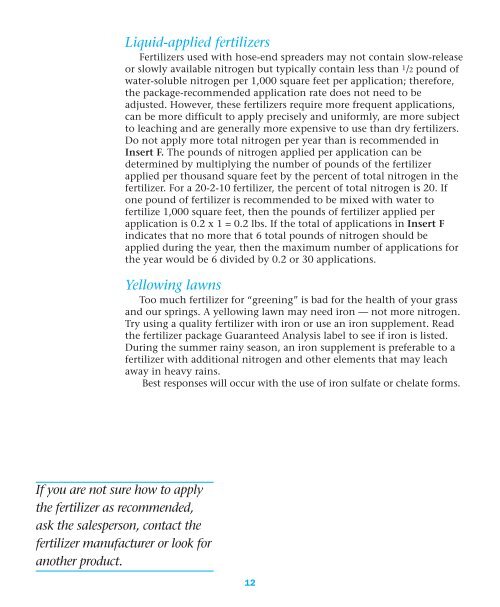What You Need to Know About Fertilizing and Watering - Southwest ...
What You Need to Know About Fertilizing and Watering - Southwest ...
What You Need to Know About Fertilizing and Watering - Southwest ...
You also want an ePaper? Increase the reach of your titles
YUMPU automatically turns print PDFs into web optimized ePapers that Google loves.
Liquid-applied fertilizers<br />
Fertilizers used with hose-end spreaders may not contain slow-release<br />
or slowly available nitrogen but typically contain less than 1 /2 pound of<br />
water-soluble nitrogen per 1,000 square feet per application; therefore,<br />
the package-recommended application rate does not need <strong>to</strong> be<br />
adjusted. However, these fertilizers require more frequent applications,<br />
can be more difficult <strong>to</strong> apply precisely <strong>and</strong> uniformly, are more subject<br />
<strong>to</strong> leaching <strong>and</strong> are generally more expensive <strong>to</strong> use than dry fertilizers.<br />
Do not apply more <strong>to</strong>tal nitrogen per year than is recommended in<br />
Insert F. The pounds of nitrogen applied per application can be<br />
determined by multiplying the number of pounds of the fertilizer<br />
applied per thous<strong>and</strong> square feet by the percent of <strong>to</strong>tal nitrogen in the<br />
fertilizer. For a 20-2-10 fertilizer, the percent of <strong>to</strong>tal nitrogen is 20. If<br />
one pound of fertilizer is recommended <strong>to</strong> be mixed with water <strong>to</strong><br />
fertilize 1,000 square feet, then the pounds of fertilizer applied per<br />
application is 0.2 x 1 = 0.2 lbs. If the <strong>to</strong>tal of applications in Insert F<br />
indicates that no more that 6 <strong>to</strong>tal pounds of nitrogen should be<br />
applied during the year, then the maximum number of applications for<br />
the year would be 6 divided by 0.2 or 30 applications.<br />
Yellowing lawns<br />
Too much fertilizer for “greening” is bad for the health of your grass<br />
<strong>and</strong> our springs. A yellowing lawn may need iron — not more nitrogen.<br />
Try using a quality fertilizer with iron or use an iron supplement. Read<br />
the fertilizer package Guaranteed Analysis label <strong>to</strong> see if iron is listed.<br />
During the summer rainy season, an iron supplement is preferable <strong>to</strong> a<br />
fertilizer with additional nitrogen <strong>and</strong> other elements that may leach<br />
away in heavy rains.<br />
Best responses will occur with the use of iron sulfate or chelate forms.<br />
If you are not sure how <strong>to</strong> apply<br />
the fertilizer as recommended,<br />
ask the salesperson, contact the<br />
fertilizer manufacturer or look for<br />
another product.<br />
12
















